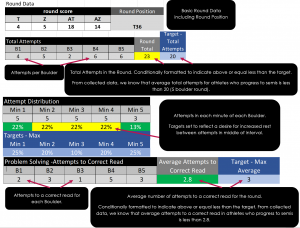USING PERFORMANCE DATA: PART 1
Quick Note on COVID-19:
We understand that many of our community are now (or will soon be) in “lockdown” and without access to training facilities. This is a very difficult time and we empathize with the challenges.
It may not be currently possible to implement the concepts presented below. A suggestion is to use the tool to analyze video of a favorite World Cup athlete. Find out how the best athletes manage time and problem solve.
In the last installment of the coach’s toolbox we looked at how to use Individual Performance Plans (IPP) and Key Performance Indicators (KPIs) to make more practice more deliberate and productive. The next installments will look how to incorporate Performance Data into training plans. It will be presented in 3 parts covering tools to track performance data in all 3 disciplines.
The collection and analysis of data from competitions and simulations (mock competitions) can provide valuable insight into an athlete’s behavioral habits. Performance Data can’t provide all the answers, but it can show where to look and where to ask more questions.
Once behaviors and/or tactics that could be improved have been identified, it is possible set targets that encourage changes.
Part 1 – Boulder InRound Tracking Form
This form tracks the following:
- Total Attempts in the Round
- Attempt Distribution for each 5 min interval
- Problem Solving
- Boulder Demands and Performance
These are 4 critical observations that provide insight into how an athlete behaves during a competition round.
Let’s look at how the form works. Click on each Image to see in Larger View
The first Tab is where data is collected:
For each Boulder in the Round, record the following:
The 2nd Tab has compiled data and ability to compare with pre set targets:
Although this form is not set up to compile it automatically, data can also be used to identify which physical and technical demands are strengths and weaknesses.
Using this form regularly in competition and simulations will help athletes understand and practice how they operate under comp conditions.
One of the benefits of tracking these types of data is to ensure that athletes are training under conditions that encourage behaviors and habits that are needed for success in competition.
A good example of this relates to time management. How often do athletes train with attempt and/or time limits on boulders? If an athlete spends the majority of training with infinite attempts and time, they will likely do the same in competition. It takes practice to be able to read a boulder and get to the first attempt within a minute, to rest longer on physically intense boulders, to trust a read and climb decisively.
A second area that can be exposed is problem solving. How often do athletes get a correct read “given” to them after only 1 attempt in training (either from coaches or watching teammates)? Does this help problem solving skills? It is the coach’s role to provide a training framework that encourages optimal habits and decision making.
In part 2, we examine a Lead InRound Tracking Form.





